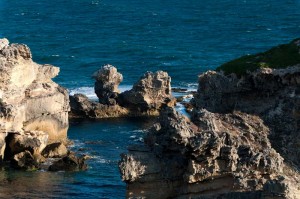The fairy penquins turned out to be a bust, or as Enid said, “they really are fairies, they’re invisible.” We waited until it was nearly dark and saw nothing. It was very cold and windy out on the point, but we did get some nice pictures of the rocks. Some of them have been named for their eroded shapes, and “Camel Rock” is probably the most impressive, though the other shapes were also identifiable.
This morning was cool, clear and sunny as we drove to Mt. Gambier. We stopped there to see the Blue Lake, and walked about 1.5 km on a short loop into the Leg of Mutton Crater which historically was used as an experimental station to grow trees, specifically pine trees imported from North America. The crater wasn’t too impressive since it was just a small grassy clearing; though it was a nice walk, there really isn’t much to see there. The deep turqouise blue colour of Blue Lake though is a very spectacular . The lake is a fairly recent volcanic crater (about 4000 to 5000 years old) which has been filled with ground water that percolates in from the surrounding limestone aquifer.
After leaving the volcano crater area we tried to get diesel. There was one service station with a good price, but it had a roof that was too low for us to get under. We drove out onto the highway and passed a Shell station, but there was a semi truck filling up with diesel, and I didn’t want to have to wait for him to finish. We drove back toward town where we’d seen another service station off to the side of the road, but when we got there it too had a roof too low to get under. So we turned back and went back to the Shell. I’m glad I didn’t have to pay his bill as it was $770. Our fuel costs (which are averaging out to about $1.31 per litre over the entire trip – but going up now) are plenty high enough!
We ate lunch at a small town, Dartmoor. Driving to the town we passed through many planted forests of pine trees (I assume of varieties imported and tested at Mt. Gambier). Forestry is one of the main industries here. It is interesting to see the forests, all of the trees in straight rows, and all the same size. Sometimes the trees were quite large, 15 to 20 metres tall, and sometimes they were just seedlings, so must have been recently planted. In the town itself they had a number of wood carvings made from some large trees. The town also had the cleanest public washrooms, and shower, that I’ve ever seen.
We stopped in at Portland to get information from the visitor centre. It is right on the harbour, so you have to drive nearly all the way into the town centre to get to it. From there we drove the few kilometres to this free camping area. It is in a forest reserve, and is very nice under tall native eucalyptus trees. There is an old remnant of a sawmill pit here so that is how it got it’s name. There were only a few people here when we arrived, though more have come since then. Enid visited for quite a while with a couple from Western Australia who are in a Winnebago Birdsville motorhome. She took them on a quick tour of ours as well, and Enid is happy that ours is much roomier internally, though it physically is almost the same size. Having the bed over the cab as we do gives us a lot more room.


